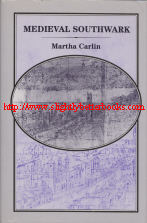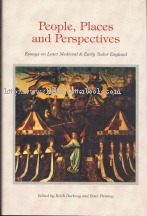
1996, The Hambledon Press, hbk
Alternative online retailers to try:
Click here to access our prebuilt search for this title on Abebooks
Or click here to access our prebuilt search for this title on Alibris
Or click here to access our prebuilt search for this title on Ebay









|
- Medieval Southwark [top]
Written by Martha Carlin
First published in 1996 in Great Britain in hardback with dustjacket by The Hambledon Press, 351pp, ISBN 1852851163
About this book/synopsis: Southwark, situated directly opposite the City of London at the southern end of London Bridge, was London's first suburb. In most modern accounts of medieval London, Southwark figures merely as a minor, but colourful adjunct of the City: the home of Chaucer's Tabard Inn, of the notorious Bankside brothels, of the Marshalsea and King's Bench prisons, and later of the theatres, including Shakespeare's Globe. To the Londoners during that time, however, Southwark was not a desirable bohemian district, but an unruly enclave of dubious people and occupations; a haven of criminals and forbidden practices. It was a commercial rival to London and it represented an administrative anachronism and a continual thorn in the side of law and order. There are few studies of London Suburbs - only two in fact (Gervase Rosser's 'Medieval Westminster 1200-1540' (1989); and Kevin McDonnell's 'Medieval London Suburbs'
(1989); and Kevin McDonnell's 'Medieval London Suburbs' (1978), and this book therefore represents a valuable and unique view to this body of work
(1978), and this book therefore represents a valuable and unique view to this body of work
Martha Carlin examines the urban development of Southwark from its Roman origins to the mid sixteenth century. She traces in detail Southwark's transformation from a semi-rural straggle of dwellings into a densely-inhabited community displaying such characteristically urban features as a diversified economy, a stratified and heterogeneous society, an excess of rubbish, and a traffic problem. Concentrating on the period from 1200 to 1550, for which documentary evidence is most abundant, Medieval Southwark reconstructs Southwark's evolution over the centuries, analysing the borough's topgraphical development, its manorial administration and religious institutions, its demographic patterns and economic structure, its stormy relationship with London, and its long process of urbanisation. This book is an important contribution to the study of medieval urban history
Contents: Acknowledgements; Maps and Illustrations; Tables; A Note on Documentation and Dating; Abbreviations
Introduction:
-
Medieval Southwark: An Overview
-
The Sources
-
Defining 'Southwark'
1. Roman and Saxon Southwark:
-Roman London and Southwark
-
The Post-Roman Period
-
The Seventh and Eighth Centuries
-
The Ninth Century
-
The Tenth and Eleventh Centuries
2. Topographical Development:
-The Twelfth and Thirteenth Centuries:
--The High Street;Newington Causeway, Kent Street and St. George's Field; Tooley Street and Horselydown; Bermondsey Street and Long Lane; The Manor of Paris Garden; The Bishop of Winchester's Manor
-The Fourteenth Century
-The Fifteenth Century
-The Tidemills of Southwark
-The Sixteenth Century
3. Religious Institutions
-The Priory
-The Hospital
-The Parish Churches:
--St. Olave's, St. Margaret's, St. George's, St. Mary Magdalen's (from 1540 St. Saviour's), St. Thomas's
-Epilogue: The Reformation in Southwark
4. Administration
-The Crown:
--The County Officers; The Royal Prisons; The Crown and the Guildable Manor
-The Manors:
--The Manor Officers; The Manor Courts
-Manorial Autonomy: The Sanctuary of Paris Garden
-Southwark and Parliament
-Southwark and London
5. Population
-Population Estimates, 1066-1300
-The Southwark Poll Tax Return of 1381
-Immigration
6. Aliens in Southwark
-The 'Doche'
-The Alien Community
-Xenophobia in London
-Legal and Commercial Strife
-A Southwark Success Story: The Career of Henry Leeke
7. Occupations and Economy
-The Poll Tax Return of 1381
-The Occupations of Women in 1381
-The Social and Economic Topography of Southwark in 1381
-Occupational and Economic Structure, 1381-1550
8. Inns and Alehouses, Hucksters and Victuallers
-Inns
-Markets and Hucksters
-Victuallers, Tipplers and Brewers
9. The Stews and Prostitution
-The Bankside Stews
-The Regulation of the Bankside Stews
-Prostitution Elsewhere in Southwark before 1500
-The Prostitutes
-The Sixteenth Century
10. Urbanization
-Embankments and Ditches
-Clean Air and Water
-Paving, Bridges, Stairs and Gutters
-Public Sanitation
-Commercial and Industrial Waste
-Livestock and Other Animals
-Refuse Disposal and Street-Cleaning
-Fire Prevention
-Other Hazards and Nuisances
-Street Lighting
-Traffic Control
-Policing
-Signposts of Urbanization
11. Conclusion
-Comparisons with Other Suburbs and Towns
-Southwark and London
-Southwark and Westminster: Defining a Town
-Southwark: An Epiolgue
Appendix I. The Southwark Poll Tax of 1381
Appendix
II. Inventory of the Marshalsea Prison, 1483
Appendix III. Domestic Immigration to Southwark, to 1350
Appendix IV. Southwark Occupations, Late Twelfth Century to 1511
Appendix V. Clergy and Manorial Officers of Southwark to 1550
Bibliography; Manuscript Sources; Typescript Sources; Printed Sources: Primary; Secondary
Index
Maps and Illustrations
Fig. 1. The Parishes of Southwark in 1539
Fig. 2. The Manors of Southwark, 1550
Fig. 3. Plan of Southwark Priory, c.1539
Fig. 4. Plan of Bankside, c.1500
Fig. 5. Plan of Winchester Palace, c.1539
Fig. 6. Plan and Gazetteer of Southwark High Street, c.1550
Fig. 7. Plan and Gazetteer of Tooley Street and Bermondsey
Fig. 8. Plan and Gazetteer of Blackman Street, Kent Street and Horselydown, c.1500
Fig. 9. Plan of Southwark c.1542, redrawn from PRO, MS MPC 64
Fig. 10. Detail from Antonis van den Wyngaerde's Panorama of London, Southwark and Westminster, c.1544-8
Tables
4.1. Occupations of Southwark MPs
5.1. Southwark Estate of Christ Church Priory, 1274-1513
5.2. Receipts from Fastolf Tenements in Bermondsey Street
5.3. Bridge House Estate in Tooley Street and Bermondsey Street, 1358-1554
5.4. Demographic Data from Southwark Poll Tax Return, 1381
5.5. Sex Ratios from Southwark Poll Tax Return, 1381
5.6. Wives, Singletons, and Servants in Six Towns
5.7. County Origins of English Residents, Property-Holders, and Witnesses in Southwark, 1000-1350
5.8. Regional Distribution of English Residents, Property-Holders, and Witnesses in Southwark, 1000-1350
5.9. Domestic Urban Immigration to 1350 (in percentages)
6.1. Alien Householders in 1440
6.2. Alien Servants and Non-Householders in 1440
6.3. Distribution of Aliens in Southwark, 1551
7.1. Occupations in Southwark, Late Twelfth Century to 1381
7.2 Assessments of Single and Married Householders in the Southwark Poll Tax Return, 1381
7.3. Topographical Sequence of Southwark Poll Tax Return, 1381
7.4 Poll Tax Assessments of Householders in Southwark, 1381
9.1. 'Stewmongers' in Southwark, 1381
|
Other Medieval British Towns
London in the Middle Ages
Books about Southwark
|

2005, Nonsuch Publishing, hbk
In stock, click to buy for £4.93, not including post and packing
Alternative online retailers to try:
Click here to access our prebuilt search for this title on Abebooks
Or click here to access our prebuilt search for this title on Alibris
Or click here to access our prebuilt search for this title on Ebay

|
About this book: Over the last 40 years, Ralph Griffiths has built up a great reputation as a prolific and distinguished historian of 15th Century England and Wales, as a master of English Prose and a first-rate teacher. For many decades, he gave loyal and conspicuous service to the University of Wales, Swansea, of which he is now Emeritus Professor of Mediaeval History [in 2005, when this was published]. This book celebrates his contribution to the study of the fifteenth century and reflects the diversity of historical approaches now taken to this turning point between the mediaeval period and the modern age. The subject matter is wide - ranging from the treasures of Henry II to early Tudor bar-room gossip and from the activities of kings and parliaments to Sir John Fastolf, a veteran of the Hundred Years War, making provision for his death.
The essays gathered here, as well as reflecting the respect and admiration their authors have for him; also dovetail nicely with Ralph Griffiths' own historical preferences and published works. His interest in 15th Century English politics and administration, and relations between central government and the provinces is clearly mirrored in the contributions of Peter Fleming, Malcolm Mercer and A. J. Pollard. His role in drawing attention to important, and frequently unpublished material is emulated in the essays by Michael Hicks, Colin Richmond, Jenny Stratford and Deborah Youngs. And both Michael Bennett and Keith Dockray make a connection with his fondness for historiography and portrayals of the fifteenth century since Tudor times with their contributions
Contents:
List of Contributors; Acknowledgements; Table of Abbreviations
1. Ralph A. Griffiths by Keith Dockray and Peter Fleming
2. Richard II's Treasure and the Forfeitures of 1397 by Jenny Stratford
3. The Administration of the Cinque Ports in the Early Lancastrian Period by Malcolm Mercer
4. Provincial Politics in Lancastrian England: the Challenge to Bishop Langley's Liberty in 1433 by A. J. Pollard
5. Politics and the Provincial Town: Bristol, 1451-1471 by Peter Fleming
6. Once Again: Fastolf's Will by Colin Richmond
7. King in Lords and Commons: Three Insights into Late-Fifteenth-Century Parliaments, 1461-85 by Michael Hicks
8. Table Tittle-Tattle and the Tudor View of History by Michael Bennett
9. House-Hunting and Home-Making in Sixteenth-Century England: the Case of Henry, Lord Stafford (1501-1563) by Deborah Younger
10. Before K. B. McFarlane: The Historical Legacy of C. L. Kingsford by Keith Dockray
11. The Published Works of Ralph Griffiths, 1963-2004
Index |
|



